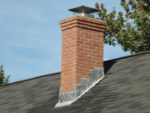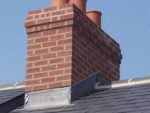This section is all about chimneys; how to repair and maintain the both externally and internally. This is not a comprehensive caminology, which is the study of chimneys although not (yet!) in the Oxford English Dictionary. This is a practical guide to has you can work with your chimney to make sure that it stays functional. There is maintenance required with chimneys and we cover how to do this is this in the projects of this section.
We cover Open Fires, Woodburners and Solid Fuel in another section, where you will be able to get more information on the actual fires, burners and boilers that will be using the flues, and specifically the chimneys.
There is a wealth of information in our section on Heating Central Heating and Boilers which covers all aspects of heating your home.
What is a Chimney?
A chimney is the structure that is built around a flue.
Flues and chimneys are often confused. Very simply, the Flue is the hole in the middle of the chimney. There is a flue liner that fits between the flue and the chimney. A more sophisticated definition from Homebuilding & Renovating describes the flue as:
the working section of the chimney which takes the products of combustion up and out into the atmosphere
Fires cannot share a flue, but can share a chimney. There can be multiple flues in a single chimney, all service a single fire each, and they will all end with a terminal of some sort, typically a chimney pot, but this could also incorporate a cowl or cap.
The Classes of Chimney Explained
There are two classes of chimneys, although there are other options for heating without needing to use a flue. The class of chimney will affect you choice of fireplace, burner or boiler. Here are the options you have:
- Class 1 – This is the traditional chimney as most people know them. To be class 1 the flue must be 178mm (7”) in diameter at least. Assuming that it is structurally sound you can use this chimney with any kind of fire place you like
- Class 2 Chimney – These chimneys have 127mm (5”) flues and are restricted in the types of appliance that can use them. Typically they can only be used by gas fires, although there are some solid fuel stoves which are certified for use with them. They can occur when an existing chimney has been lined with a narrower steel flue
- Pre Cast Flue – These are flues that end with a box like terminal and the flue will have a rectangular cross-section. They can only be used with certain types of gas fire, but take up considerably less space than a traditional chimney. A Pre Cast Flue (image: AC Chimneys)
- No Chimney or Flue – If there is no flue in your home, then you should only be using electric heating (less than 2kW) or certain flueless gas appliances. The alternative is to have a flue added.
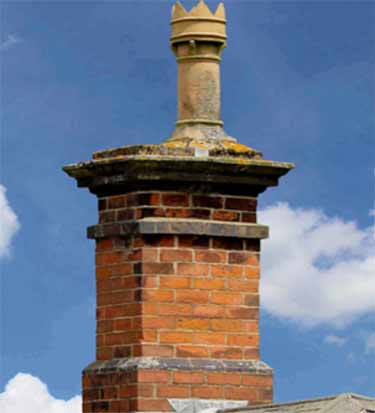
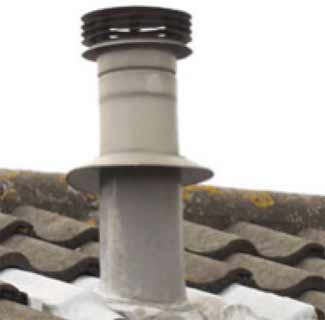
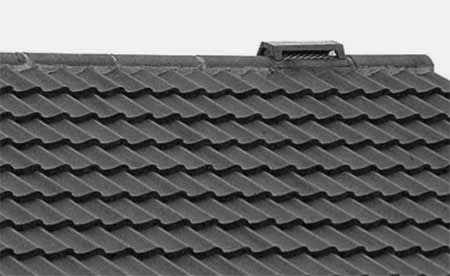
Parts of a Chimney Stack
There are a number of common parts of a chimney stack that are helpful to know before getting into a detailed chimney project. The part of the chimney that sticks out above the roof is called the Stack.
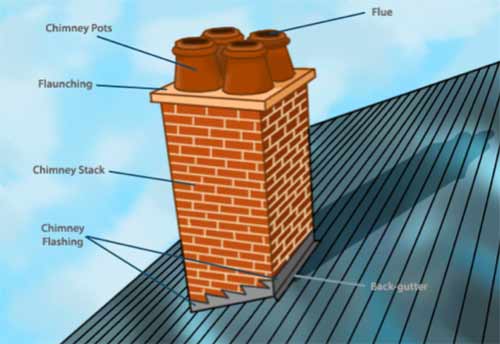
- Chimney stack – as we have already mentioned this is the part of the chimney that protrudes above the roof
- Pots – The chimney pots are the end of the flues that allow the exhaust gasses to diffuse into the atmosphere. There is a rich (and poorly reported) history of chimney pots in this country
- Flaunching – this is the cement mortar that fixes the pots in place on the top of the chimney. It can sometimes be referred to as Benching or a Crown. It must stop the weather and water getting into the flue and damaging the chimney. It often sits on top of corbelling, the stepped out brickwork which creates an overhang from the rest of the stack. Occasionally it can be a block of concrete which has been cast in situ
- Back Gutter – This is the “valley” between the roof and the inside side of the stack. If the chimney exits the roof that the apex there will not be a gutter. It can be called a Lead Tray. This should move the water from behind the stack to continue to follow down the roof either side of the chimney
- Flashing – or flashings. This is the lead work that creates a watertight seal between the chimney and the roof. This is often when many of the problems occur and can lead to leaks
This section focuses on how to maintain and repair your chimney. This will prevent leaks through the roof next to the stack and ingress of water into the chimney itself, which can cause damp inside your home, particularly if the flue is not being used.

